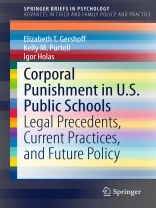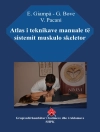This Brief reviews the past, present, and future use of school corporal punishment in the United States, a practice that remains legal in 19 states as it is constitutionally permitted according to the U.S. Supreme Court. As a result of school corporal punishment, nearly 200, 000 children are paddled in schools each year. Most Americans are unaware of this fact or the physical injuries sustained by countless school children who are hit with objects by school personnel in the name of discipline. Therefore,
Corporal Punishment in U.S. Public Schools begins by summarizing the legal basis for school corporal punishment and trends in Americans’ attitudes about it. It then presents trends in the use of school corporal punishment in the United States over time to establish its past and current prevalence. It then discusses what is known about the effects of school corporal punishment on children, though with so little research on this topic, much of the relevant literature is focused on parents’ use of corporal punishment with their children. It also provides results from a policy analysis that examines the effect of state-level school corporal punishment bans on trends in juvenile crime. It concludes by discussing potential legal, policy, and advocacy avenues for abolition of school corporal punishment at the state and federal levels as well as summarizing how school corporal punishment is being used and what its potential implications are for thousands of individual students and for the society at large. As school corporal punishment becomes more and more regulated at the state level,
Corporal Punishment in U.S. Public Schools serves an essential guide for policymakers and advocates across the country as well as for researchers, scientist-practitioners, and graduate students.
Tabla de materias
Introduction.- Prevalence of and Attitudes About School Corporal Punishment in the U.S.- Gender, Race, and Disability Disparities in Who is Subject to School Corporal Punishment.- School Corporal Punishment Effects on Children.- Policy Analysis: School Corporal Punishment Bans and Juvenile Crime.- The Legal Basis for School Corporal Punishment.- Legal and Public Policy Strategies to Reduce or Ban School Corporal Punishment.- Education and Advocacy Approaches to Reduce School Corporal Punishment.- Conclusion.
Sobre el autor
Elizabeth Gershoff, Ph.D., is an associate professor of Human Development and Family Sciences and a faculty associate and postdoctoral training director at the Population Research Center, both at the University of Texas at Austin. She is a developmental psychologist who studies child and adolescent development in the context of families, schools, neighborhoods, and public policies. She is an internationally recognized expert in the effects of parents’ use of corporal punishment on children.
Kelly Purtell, Ph.D., is an assistant professor in the Department of Human Sciences at The Ohio State University who studies how economic disadvantage influences health and development across the lifespan. In particular, her research focuses on how contextual factors shape development among low-income children and adolescents, and how public policies can enhance the developmental trajectories of these youth.
Igor Holas, M.A., is a graduate student interested in links between education policy generally and state and local education funding in particular on the academic success of children and adolescents. He is the founder of Mentegram, an online tool for therapists and clinicians to track patient progress.












